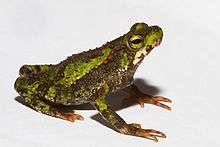Incilius
| Incilius | |
|---|---|
 | |
| Incilius coniferus is the type species of genus Incilius | |
| Scientific classification | |
| Kingdom: | Animalia |
| Phylum: | Chordata |
| Class: | Amphibia |
| Order: | Anura |
| Family: | Bufonidae |
| Genus: | Incilius Cope, 1863 |
| Type species | |
| Bufo coniferus Cope, 1862 | |
| Synonyms[1] | |
|
Cranopsis Cope, 1875 "1876" (junior homonym of Cranopsis Adams, 1860 (Mollusca) and Cranopsis Dall, 1871 (Brachiopoda)) | |
Incilius is genus of toads in the true toad family, Bufonidae.[1][2][3] They are sometimes known as the Central American toads or Middle American toads and are found in southern USA, Mexico, Central America, and northern Pacific South America (Colombia and Ecuador).[1] They are an ecologically and biogeographically diverse group of toads, including micro-endemic species such as Incilius spiculatus that are restricted to undisturbed cloud forests, and widespread lowland species such as Incilius valliceps that predominantly occur in disturbed habitats.[4]
Taxonomy and systematics
Taxonomy and systematics of Incilius has seen many recent changes. Current delineation of the genus was achieved by 2011 when both Cranopsis/Ollotis and Crepidius/Crepidophryne had been brought into synonymy with Incilius. However, the monophyly of Incilius is threatened by Incilius bocourti, which might be the sister taxon of Anaxyrus.[1]
Another discussion has been the taxonomic level at which the genus is recognized. Incilius did not see wide recognition before the large-scale revision of amphibian systematics by Darrel Frost and colleagues in 2006,[5] then under the name Cranopsis, including the former "Bufo valliceps group" and some related species. However, others have argued that Incilius should be treated as a subgenus of Bufo.[6]
Species
There are at present 39 species:[1]
- Incilius alvarius (Girard, 1859)
- Incilius aucoinae (O'Neill and Mendelson, 2004)
- Incilius aurarius Mendelson, Mulcahy, Snell, Acevedo, and Campbell, 2012
- Incilius bocourti (Brocchi, 1877)
- Incilius campbelli (Mendelson, 1994)
- Incilius canaliferus (Cope, 1877)
- Incilius cavifrons (Firschein, 1950)
- Incilius chompipe (Vaughan and Mendelson, 2007)
- Incilius coccifer (Cope, 1866)
- Incilius coniferus (Cope, 1862)
- Incilius cristatus (Wiegmann, 1833)
- Incilius cycladen (Lynch and Smith, 1966)
- Incilius epioticus (Cope, 1875)
- Incilius fastidiosus (Cope, 1875)
- Incilius gemmifer (Taylor, 1940)
- Incilius guanacaste (Vaughan and Mendelson, 2007)
- Incilius holdridgei (Taylor, 1952)
- Incilius ibarrai (Stuart, 1954)
- Incilius karenlipsae Mendelson and Mulcahy, 2010
- Incilius leucomyos (McCranie and Wilson, 2000)
- Incilius luetkenii (Boulenger, 1891)
- Incilius macrocristatus (Firschein and Smith, 1957)
- Incilius majordomus Savage, Ugarte, and Donnelly, 2013
- Incilius marmoreus (Wiegmann, 1833)
- Incilius mazatlanensis (Taylor, 1940)
- Incilius mccoyi Santos-Barrera and Flores-Villela, 2011
- Incilius melanochlorus (Cope, 1877)
- Incilius nebulifer (Girard, 1854)
- Incilius occidentalis (Camerano, 1879)
- †Incilius periglenes (Savage, 1967)
- Incilius peripatetes (Savage, 1972)
- Incilius perplexus (Taylor, 1943)
- Incilius pisinnus (Mendelson, Williams, Sheil, and Mulcahy, 2005)
- Incilius porteri (Mendelson, Williams, Sheil, and Mulcahy, 2005)
- Incilius signifer (Mendelson, Williams, Sheil, and Mulcahy, 2005)
- Incilius spiculatus (Mendelson, 1997)
- Incilius tacanensis (Smith, 1952)
- Incilius tutelarius (Mendelson, 1997)
- Incilius valliceps (Wiegmann, 1833)
The AmphibiaWeb recognizes Incilius intermedius (Günther, 1858) as a valid species,[2] whereas the Amphibian Species of the World considers it a synonym of Incilius occidentalis (Camerano, 1879).[1]
References
- 1 2 3 4 5 6 Frost, Darrel R. (2017). "Incilius Cope, 1863". Amphibian Species of the World: an Online Reference. Version 6.0. American Museum of Natural History. Retrieved 4 July 2017.
- 1 2 "Bufonidae". AmphibiaWeb: Information on amphibian biology and conservation. [web application]. Berkeley, California: AmphibiaWeb. 2017. Retrieved 4 July 2017.
- ↑ Vitt, Laurie J.; Caldwell, Janalee P. (2014). Herpetology: An Introductory Biology of Amphibians and Reptiles (4th ed.). Academic Press. p. 490.
- ↑ Mendelson, J. R. III; D. G. Mulcahy; T. S. Williams; J. W. Sites, Jr. (2011). "A phylogeny and evolutionary natural history of mesoamerican toads (Anura: Bufonidae: Incilius) based on morphology, life history, and molecular data" (PDF). Zootaxa. 3138: 1–34.
- ↑ Frost, D. R.; Grant, T.; Faivovich, J. N.; Bain, R. H.; Haas, A.; Haddad, C. L. F. B.; De Sá, R. O.; Channing, A.; Wilkinson, M.; Donnellan, S. C.; Raxworthy, C. J.; Campbell, J. A.; Blotto, B. L.; Moler, P.; Drewes, R. C.; Nussbaum, R. A.; Lynch, J. D.; Green, D. M.; Wheeler, W. C. (2006). "The amphibian tree of life". Bulletin of the American Museum of Natural History. 297: 1–291. doi:10.1206/0003-0090(2006)297[0001:TATOL]2.0.CO;2. hdl:2246/5781.
- ↑ Pauly, Greg B.; Hillis, David M.; Cannatella, David C. (2009). "Taxonomic freedom and the role of official lists of species names" (PDF). Herpetologica. 65 (2): 115–128. doi:10.1655/08-031R1.1. Archived from the original (PDF) on July 26, 2011.